
FWA: Market, Applications and Technology – Part 2
Fixed Wireless Access (FWA) enables network operators to deliver ultra-high-speed broadband to suburban and rural areas, supporting home and business applications where fiber is prohibitively expensive to lay and maintain. The advent of 5G is allowing mobile technology to intersect with the demands of fixed line services and price points as well so FWA is becoming for service providers an enabler for enhanced broadband services.
In this second part of our article, we will focus on technology aspects of FWA which promises to be a viable alternative for service providers to full-fibre and fibre-copper infrastructure
FWA ARCHITECTURE
FWA Radio Access Network
Fixed wireless access (FWA) refers to a wireless link that provides connectivity to objects that are stationary or nomadic (i.e. almost no movement when connectivity is used). Because this concept has already been frequently used as a substitute to wireline connection in the last mile, it is often compared with other last mile connectivity solutions such as FTTx (Fibre-to-the-x) and xDSL (x Digital Subscriber Line).
5G, in all its deployment options, enables the FWA to be competitive substitute to FTTx with its superior radio capabilities to previous wireless technologies and therefore offers business opportunities for the service providers and carriers.
Figure 1 shows a reference architecture for FWA radio access network. Basically, the coverage is realized through a compact FWA Access Unit installed on an utility pole (more antennas can be installed in order to cover a wide area. The type of antenna depends on frequency range) and equipped with radio part and/or baseband, depending if the operator has selected a distributed radio access network architecture fully or partially centralized (aka. C-RAN). While a fiber connection is mandatory with this approach due to the high capacity of CPRI interface (i.e. fronthaul/midhaul), in some cases where a fiber facility is not available, a licensed radio link can be used for backhauling. This requires necessarily a local termination of CPRI interface if air interface bandwidth is not enough so a cabinet with a power feeder and housing a L3/L2 equipment with sync management capability needs to be installed.
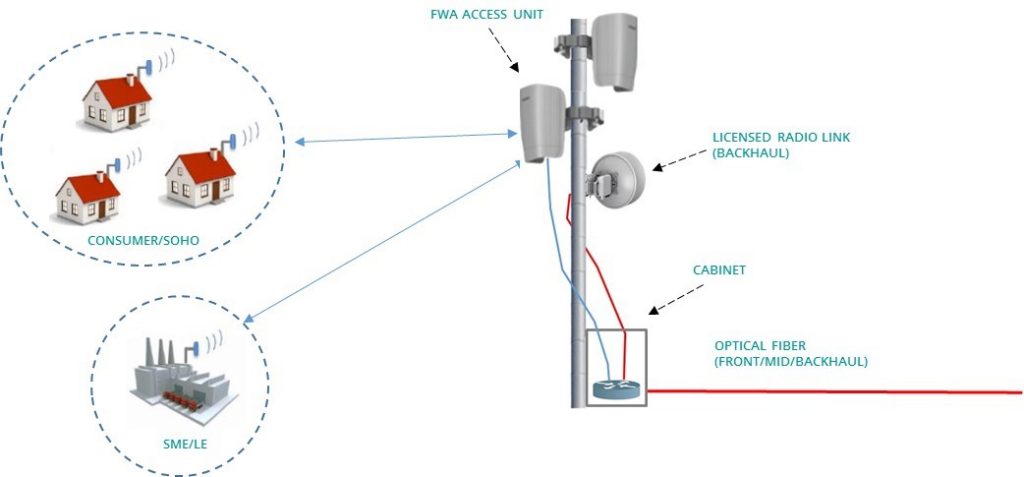
As we will introduce later, this last one, as massive backhaul approach, is less efficient in terms of performance and cost-effective than a centralized-RAN based architecture because it increases CAPEX and OPEX of the whole access network solution
FWA core network
Converged operators (i.e. mobile and fixed operator) have most of the knowledge, processes and network components (such as BSS systems, network management and core networks) needed to offer an FWA service. This means they can realize synergy and cost benefits between existing assets and FWA putting them in an excellent position with a clear advantage over greenfield stand-alone FWA providers un terms of price competition.
A 3GPP core network already deployed is able to handle high numbers of flows and high volumes of traffic. When adding FWA, operators should just ensure that handling of the additional data is suitably ‘low touch’, avoiding unnecessary cost. Surely, some functionalities that will be valuable for FWA, including new ways of regulating bandwidth or data rates, flexible charging support, and limiting the use of FWA to a local geographical area can be considered.
Beside that, operators can reuse some components of the fixed access core network. This typically involves functions on the Internet side of the Broadband Network Gateway (BNG), such as Network Address Translation (NAT), firewall and caching
In the service layer domain, policy control is often already deployed as well as network management. Both layer can be reused for FWA service.
Operators may consider additional management tools to optimize their understanding of network performance in the FWA-launched areas, and for detailed analysis of customer behavior and generated traffic. In the BSS field, operators will need to add the desired charging schemes for FWA. Depending on the degree of convergence between the operator’s mobile and fixed BSS systems, the operator can choose whether to reuse mobile or fixed BSS systems and principles for FWA
New FWA CPE is needed, from simple indoor nomadic devices to fixed outdoor-installed units, and provisioned through standard device retail or new methods. A new CPE management system is likely to be needed to manage CPE in the fixed broadband sense– enabling the operator to log in to the devices, configure them and check status remotely. Converged operators have the choice of reusing the fixed access CPE management system or deploying a separate one for FWA. Both CPE and CPE management systems are separate network entities with generally quite limited integration with cellular networks, meaning that the operator can acquire best-of-breed products and expect them to work using standard protocols.

Initial FWA trials using 5G New Radio employ a classic Evolved Packet Core (EPC) infrastructure for data transport and control information. Commonly referred to as Option 3x, the new gNodeB’s (gNB’s) supporting FWA and other early 5G deployments operate in a Non-Standalone (NSA) manner alongside the existing 4G eNodeB. Option 3 reduces deployment risks and variables when first implementing 5G FWA.
However, the granular nature of 5G antenna distribution, along with the high bandwidth streaming applications being delivered over FWA services, will quickly necessitate more capacity in the access network plus a far greater density of distributed user plane aggregation points.
LTE Control and User Plane Separation (CUPS) techniques can provide a partial solution to these problems but involve prolonging a predominantly hardware-centric approach to delivering the data plane. This is an expensive and complex proposition which will also have the effect of prolonging the migration to a true cloud native 5G Core, as outlined in industry standards and specifications.
In contrast, a 5G User Plane Function (UPF) deployed within a highly automated Multi-access Edge Compute (MEC) cloud environment (with dynamic scaling and autonomous network slicing) can truly meet the prerequisites of a Fixed Wireless Access infrastructure.
With this cost-effective data plane in place, the adoption of a complete 5GC control plane Service Based Architecture (SBA) can be dramatically simplified:
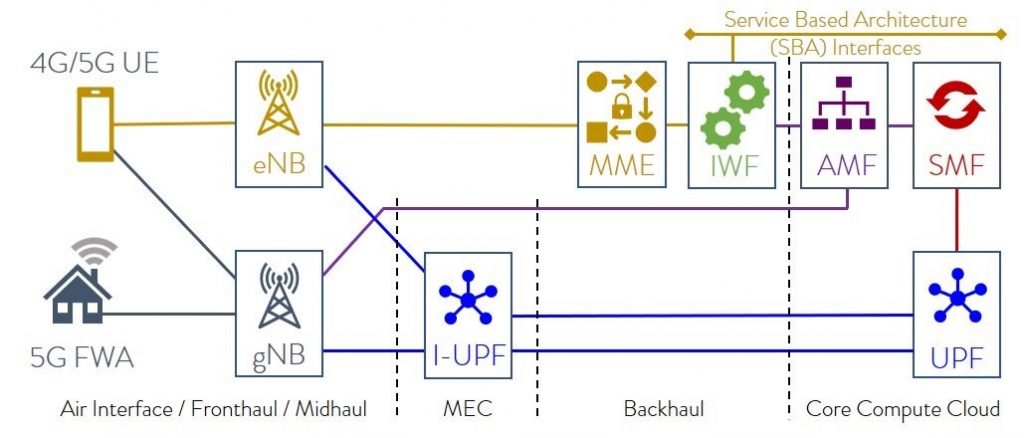
By eliminating the need to update existing Radio Access Network (RAN) equipment or completely eradicate the 4G control plane, a 4G/5G Control Plane Interworking Function (CP-IWF), implemented northbound of the Mobility Management Entity (MME), would complete this approach to enabling existing mobile LTE users to exploit the 5G Core infrastructure alongside FWA subscribers.
FWA CPE solutions
Differently from other mobile broadband solutions based on tethering or an indoor mobile router with wide-area wireless capabilities (such as LTE), the FWA access is provisioned with a wide-area wireless-capable (such as 3GPP) device.
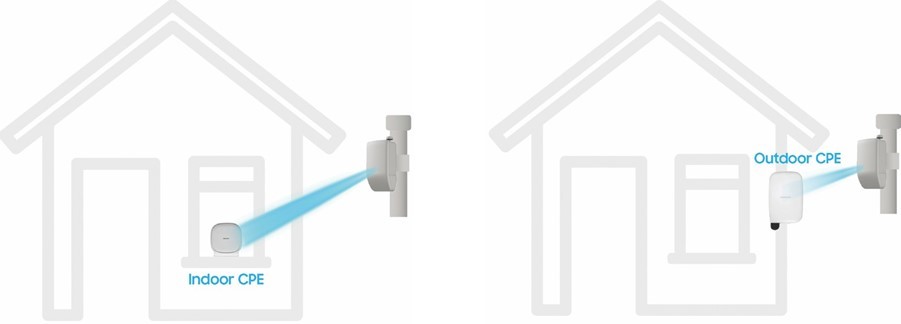
Outdoor CPE could be an outdoor-mounted on a roof or wall (outdoor unit), equipped with a directional antenna to improve performance and an LTE/NR modem. Typically the modem is connected through an Ethernet POE standard interface to an indoor gateway with added some router and Wi-Fi functionalities and or additional applications (see fig. 5).
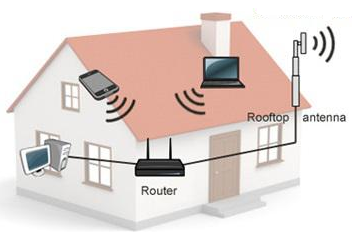
When signal performance is not an issue, the alternative configuration is an indoor CPE fully integrated unit with an omni-antenna, LTE/NR modem with integrated router and Wi-Fi capabilities as well as additional applications such as VoIP SIP client, firerwall etc.
Beside the lower antenna gain, which makes indoor CPE less suitable that outdoor CPE when many households are served, another side effect of “all-in-one” box is that while LTE/NR modem evolves in line with 3GPP standardization, the Wi-Fi unit follows the IEEE standards.
Another issue is related to CPE supply. While indoor CPE can be sold to end-users in stores or delivered to their homes, the outdoor one are normally owned and installed by the operator.
Both types of CPE can be normally managed according to the fixed broadband paradigm, enabling remote configuration and fault management from a customer service center over standard protocols (i.e. TR-069/TR-143).
FWA APPLICATION SCENARIOS AND BUSINESS MODELS
FWA offers an opportunity to double the impact of a 5G deployment by addressing the two prominent 5G use cases simultaneously: enhanced mobile broadband and massive IoT.
Not only. Even if many operators look to 5G FWA mainly as suitable fast and low-cost replacement of fixed broadband technologies, it appears capable of addressing the bandwidth saturation issue caused by the high demand in urban areas for typical residential services such as video streaming from web platforms like YouTube.
In so complex application scenarios for residential or business users, the price plan and the subscription agreements can depend on several factors such as:
- Availability of a fixed broadband offering in the same area or bundle with mobile services.
- Guaranteed QoS offering, mainly for business segment.
- Nomadic service level offering (depending on CPE features/capabilities, the operator can decide to offer – or not – a nomadic service when the CPE is moved into other locations agreed with or requested by the Customer).
Another interesting scenario is related to the infrastructure providers. The FWA launches in high-band and mmWave spectrum in urban/semi-urban areas will need small cells on light-poles or other street furniture, given the short range and (near) line-of-sight requirements of the transmitters. This may mean a reliance on fibre-to-the-small-cell, as the installations might not be suitable for wireless backhaul.
Service Providers like MNOs without a fixed broadband network may be happy to sell 5G fixed-wireless access to homes instead of FTTx in some places. As said above, mobile operators can complement their mobile broadband offers with FWA and fixed operators should be able to extend their reach with less expensive last-mile FWA drops.
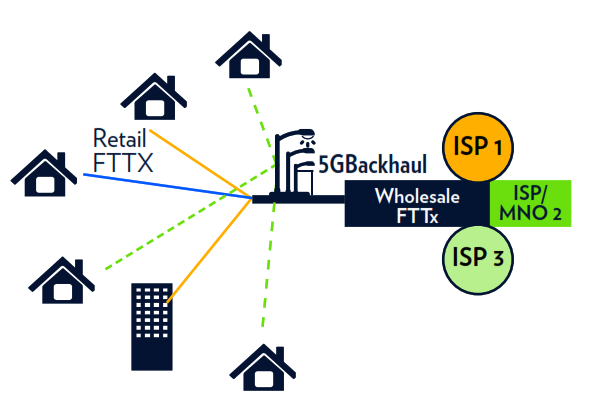
In these cases, the wholesale infrastructure provider could provide backhaul services for localized small-cells, for example to lampposts or utility poles on each street or neighborhood.
This will likely need a different product set (for instance Ethernet rather than PON) but could present the infrastructure owner with a different revenue stream.
Surely, a regulation with a transparent offer is needed in order to avoid that the infrastructure provider can be a privileged 5G FWA player and become a competitive threat for all the Service Providers.
FWA SPECTRUM
For decades mobile networks had been confined to a relatively narrow band of the radio spectrum generally between 600MHz and 2600MHz – a total space of about 2GHz. But with 5G technology, more spectrum above 6 GHz band has been permitted for use becoming the preferred band for the very first deployments of 5G-based FWA networks.
Spectrum is normally auctioned and acquired nationwide or over large areas or markets, including urban, suburban and rural areas. The full capacity is often only needed in urban areas for MBB.
In addition to the bands used for legacy cellular technologies, new spectrum with large bandwidths is becoming available in increasing quantities. This includes mid-band TDD spectrum in the 3.5–4.5 GHz range, 20–100 MHz per operator, and high bands in the mmWave range, notably 28, 37 and 39 GHz, 400–800 MHz per operator.
Such broad bands can carry large amounts of traffic. This is one of the reasons the FWA opportunity has come to the fore recently. All these bands are important for enhanced MBB and can also benefit FWA – as long as operators view their spectrum assets as one common pool, and deploy carrier aggregation between LTE carriers, and dual connectivity with NR (which we strongly recommend as a general rule).
Many countries such as the US, Europe, Korea, and Japan have recently announced their 5G spectrum strategies, showing that the year 2018-2020 is the right time for 5G commercial systems deployments using mmWave bands.
The following picture summarizes the frequency plan allocated/under discussion in all those countries involved in 5G deployment.
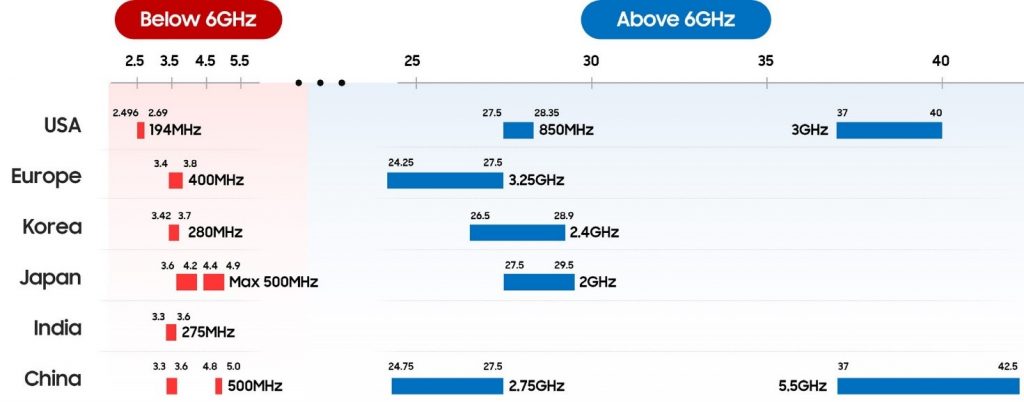
As already wrote in the part 1, 5G FWA in the band below 6GHz of the wireless spectrum can be used to quickly and cheaply deliver an alternative to wired broadband even it can provide a moderate throughput, making the 3.4-3.8 GHz band more appropriate for low/mid density suburban or rural areas.
In the millimeter wavelengths (i.e. above 6 GHz), 5G FWA, due to more wide bands available per operator, can provide a level of service bitrate capacity comparable to fiber optics.
This means it can be used in urban area for densification matching higher peak rates and thereby meet increasing bandwidth and latency requirements.
The major drawback of mmWave-based solution is the low penetration through common building materials – including newer types of glass, so an external antenna is required.
FWA TECHNICAL CHALLENGES AND SOLUTIONS
Operator that wants to deploy an FWA network must consider the different technical challenges concerning the following issues:
- Reuse of existing network assets, both related to radio and core part
- Add of network capabilities like FWA CPEs management
- Coverage and densification of radio network
In this last paragraph, some considerations related to coverage/throughput and backhaul issue are investigated.
FWA Challenges: radio coverage and backhaul
The primary challenges with FWA lie predominantly within the spectrum being used. In order to deliver a compelling alternative to today’s wireline broadband, wireless solutions need to be able to meet capacity and throughput demands in line with common expectations for FTTH-type services.
Because very limited availability of spectrum below 6GHz, mmWave (above 20GHz) remains the ideal target for FWA-type solution, and in turn, this means that we need new technology and tools to plan and deploy around the limitations of high frequency radio signals.
Non-ideal line of sight conditions, high-density tree foliage and certain types of glass designed to reduce thermal radiation (often referred to as low-emissivity, or low-e glass) can greatly reduce signal quality, leading to significantly lower-than-expected throughputs and consequently a poor user experience.
Not only. High frequency (i.e. 26 or 28 GHz) are not suitable for long-reach coverage like lower ones (i.e. 3.5GHz) even if the small bandwidth at these frequencies does not allow high traffic rate needed for video streaming services.
Last, FWA poses new challenges in providing cell site connectivity. Compared with conventional macro deployment, FWA may require 10 times more cells and cell site connections, putting a significant stress on backhaul network. Another important issue to be consider is the RAN split used that have a direct impact onto required transport capacity per site.
FWA Technical Solutions
Beamforming
In order to overcome these challenges, many vendors have developed several key solutions that have demonstrated a high degree of success.
A technique called ‘beamforming’ maket it easier to provide coverage at high frequencies. An advanced signal processing shapes the radio signal into a tight, flashlight-like beam that accurately targets each individual device. This is often referred to as multi-user multiple-input, multiple-output (MU-MIMO).
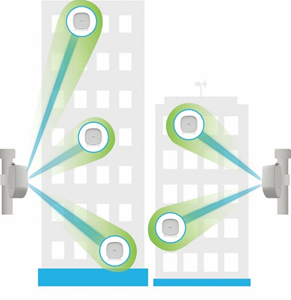
This allows confining the radio output energy into a small area, significantly extending the range and penetration capability of mmWave signals.
A stronger, confined signal can better penetrate foliage, and allows for clever manipulation of the beam, such as bouncing it off of surfaces in the environment to reach devices that don’t have direct line-of-sight with the AU.
This technique, supported by an accurate radio-planning, can potentially save costs associated with dispatching technicians to areas with poor service availability and avoid customer disappointment.
The possibility of using high-gain antennas on the terminal side (both indoors and outdoors) makes the higher frequencies more useful. The more static channels simplify beamforming and MU-MIMO user pairing.
An optimal 5G FWA solution is to include hybrid terminal antenna placement, where users farthest from the RRH/AU use rooftop while the closest to it use outdoor wall-mounted antenna or indoor CPE.
FWA backhaul
With 5G, several functional splits have been proposed to enable new scenarios for the deployment of a RAN functions across sites:
- CPRI/Evolved CPRI
- Split-PHY
- MAC-PHY split
While the first scenario refers to a RAN split that corresponds to full resource centralization with all baseband signal processing taking place at the BBU pool (i.e. Central Office, CO), the other two need additional processing at RRH side with a consequent reduction of network bandwidth and an increase of latency.
However, many other different parameters determine network site capacity such as the number of antennas, traffic load, bandwidth, SNR etc. This could lead to a capacity per site from a few gigabit-per-second (Gbps) till to 40-100Gbps.
With this so high bitrate requested on link between the radio site and CO, it is quite evident that the only media with a so high capacity available is the fiber. Any other alternative solution such as a radio-link will lead to a low capacity per user.
On this basic assumptions, the operator can decide to implement a full-centralized solution (i.e. fronthaul) or not (i.e. midhaul) as well as a passive or active framed optical networking approach.
One advantage of a centralized solution (aka C-RAN) is to limit the need of a cabinet with active equipment with a relevant reduction of CAPEX and OPEX of whole solution. In this scenario, a full-passive multiplexing solution can be implemented as shown in figure 10.
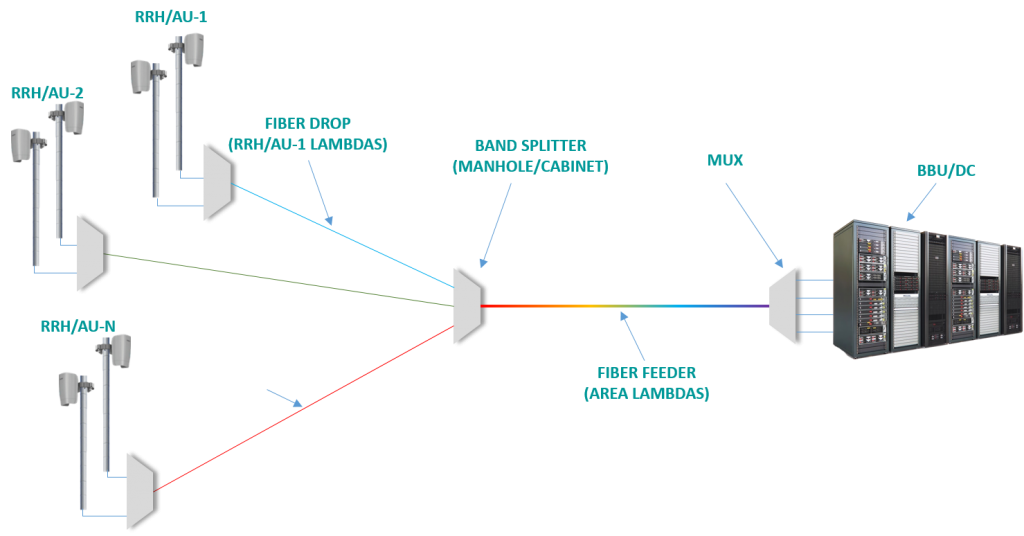
It is worth noticing any issue related to latency is only related to the transmission delay of fiber because no additional equipment are installed close to the RRH/AU for traffic backhaul.
With one single fiber is possible to connect a cell site and guarantee enough capacity to end-users served.
OPNET has designed a passive xWDM solutions (see figure 11) capable to connect till to 32 antennas in O-band per fiber (and even more in C-band) with a capacity per antenna scalable from 10G (i.e. Option 7) to 25G (i.e. Option 8).
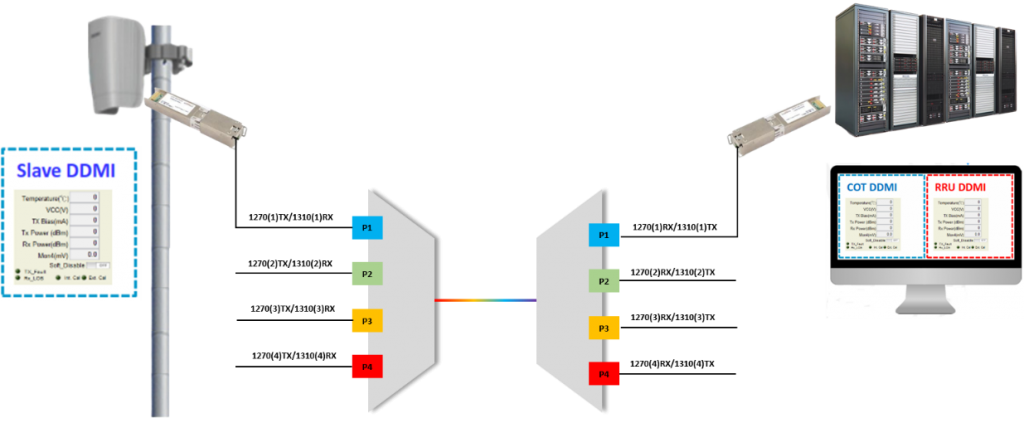
The benefits of OPNET solution are several:
- it is a vendor agnostic platform; that means an operator can get the same performance regardless the radio technology used.
- It offers easy installation and operation with the use of auto-tunable transceivers that select automatically the wavelength-cannel and transmit remote SFP-DDMI (Digital Diagnostic Monitor Interface) for optical performance control (i.e. power, ER, wavelength channel, LOS level etc.)
The bandwidth growth requested on front/midhaul segment has a direct impact on backhaul one for which a scale up of capacity in terms of channels/bandwidth is needed.
Also in this case, it is possible to implement a solution based on passive multiplexing that can allow increasing of a link capacity without adding new equipment for optical transport network or changing router interfaces from 10G to 100G.
(FWA: Market, Application and Technologies – Part 1)
ABOUT OPNET
OPNET Solutions is a company based on highly skilled people with decades years of technical and managerial experience in ICT, Telco and Energy industries and technologies.
Our purpose is to provide, to big and small companies, high-end tools and resources to empower and grow their business.